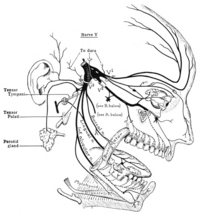
Photo from wikipedia
AbstractAimImage-guided cervical nerve root injections can cause serious complications including spinal cord infarction. This risk may be increased in patients with carotid stenosis who develop collateral arteries. The aim of… Click to show full abstract
AbstractAimImage-guided cervical nerve root injections can cause serious complications including spinal cord infarction. This risk may be increased in patients with carotid stenosis who develop collateral arteries. The aim of this study is to describe the prevalence, and anatomical location, of arterial collateral vessels in relation to the optimal needle tip position in cervical nerve root injections. Materials and MethodsThis retrospective study included 25 patients who had > 70% stenosis on a carotid CT angiogram. For each foramen the position of collateral arteries and the most anterior point of the facet joint were recorded, as Cartesian coordinates, by two independent observers. Descriptive statistics were used to analyse and present the results.Results14 patients had unilateral and 11 had bilateral stenoses. A total of 85 collaterals were identified at all levels, the most common being C2/3. The median distance from collateral to optimal needle tip placement was 9.6 mm (95% CI median: 6.7–12.4, IQR: 5.6–15.6). The minimum distance was 2.9 mm. Inter-observer reliability was “substantial” (ICC 0.78, 95% CI 0.71–0.83).ConclusionCollateral arteries were common in our cohort of patients with carotid artery stenosis and half lay within 10 mm of the optimal position for transforaminal cervical nerve root injection.
Journal Title: CardioVascular and Interventional Radiology
Year Published: 2019
Link to full text (if available)
Share on Social Media: Sign Up to like & get
recommendations!